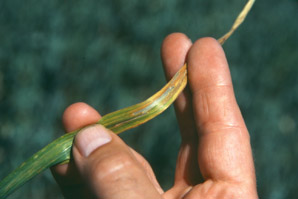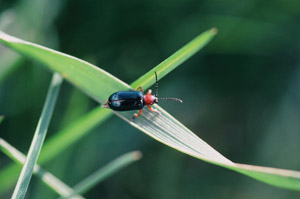
Features
Herbicides
Seed & Chemical
Refining herbicide rotation recommendations
Herbicide rotations should also consider relative risk of selection for herbicide resistance.
November 27, 2007 By Top Crop Manager
The general rule of thumb for managing herbicide resistance has been to rotate
between herbicide groups based on mode of action, and as a general guideline,
not to use a herbicide more than once in three years. Now, weed scientists Hugh
Beckie, with Agriculture and Agri-Food Canada at Saskatoon, and Linda Hall,
with the Department of Agriculture, Food and Nutritional Sciences at the University
of Alberta in Edmonton, have developed supplemental recommendations that strengthens
farmers' abilities to manage herbicide resistance.
"We now say that you should use high risk products as little as possible,"
Hall said at the Saskatchewan Soil Conservation Association 2005 annual conference,
in explaining the new approach. "Farmers should plan their herbicide rotations
based on an assessment of how likely a weed will develop resistance to a herbicide
group."
A quick herbicide resistant primer
Herbicides are grouped together based on the mode of action. Up until now, the
recommendations have been to rotate between herbicide groups, but the recommendations
did not take into account the relative risk of a weed developing herbicide resistance.
 |
| Plan herbicide rotations based on relative risk of herbicide resistance. |
Hall says that not all herbicide groups are alike in their ability to select
for herbicide resistant weeds. Some, like Group 4 herbicides 2,4-D and MCPA,
have been used for more than 50 years with limited selection of resistant weeds.
Others, like Group 2 herbicides Glean and Ally, were on the market for only
a few years before there were substantial numbers of resistant cases. That led
the scientists to search for better ways to make herbicide rotation recommendations.
Several factors are responsible for differences in the risk. Effective herbicides
place more selective pressure on weed populations than do less effective herbicides.
Similarly, residual herbicides place a longer duration of selection pressure
on weeds than do non-residual herbicides. The longer a herbicide is active in
the soil, the more the field population is depleted of susceptible plants, leaving
only resistant ones to increase.
However, Hall says that these factors do not account for all of the differences
between herbicide risk. The way a weed can be selected to be resistant to a
herbicide is also a factor.
Plants have the ability to degrade some herbicides before they cause harm.
This is the basis of selectivity between weed and crop for many herbicides.
Selective herbicides can enter crop plants, but are rapidly broken down and
do not control the crops. When the same herbicide enters a weed, it is not degraded
quickly and the weed is controlled. For example, wheat metabolizes a Group 1
(grass) herbicide but wild oats does not metabolize the herbicide and is controlled.
However, repeated applications of those Group 1 products will screen the wild
oats population for any individual plants that have the ability to metabolize
the herbicide. These rare individuals survive and reproduce, increasing in number.
| Table 1. Relative risk of selection of herbicide resistance by herbicide group and weed species. |
||||||||
| – | Wild oats | Green foxtail | Wild mustard | Cleavers | Spiny annual sowthistle |
Chick weed |
Red root pigweed | Kochia |
| Group 1 | High | High | n/a | n/a | n/a | n/a | n/a | n/a |
| Group 2 | High | High | High | High | High | High | High | High |
| Group 3 | Low | Moderate | n/a | n/a | n/a | Low | Low | Low |
| Group 4 | n/a | n/a | Moderate | Low | Low | Low | Low | Low |
| Group 5 | n/a | n/a | Moderate | Moderate | Moderate | Moderate | Moderate | Moderate |
| Group 6 and 7 | Low | Low | Low | Low | Low | Low | Low | Low |
| Group 8 | Moderate | n/a | n/a | n/a | n/a | n/a | n/a | n/a |
| Group 9 | Low | Low | Low | Low | Low | Low | Low | Low |
| Group 10 | Low | Low | Low | Low | Low | Low | Low | Low |
| Group 22 | Low | Low | Low | Low | Low | Low | Low | Low |
| n/a: Products do not usually control these weeds and therefore are not selected for resistance. Source: Principles of herbicide resistance in weeds. Hall and Beckie, SSCA 2005 Proceedings. |
||||||||
Herbicides such as Group 1 products, which are readily degraded, are more likely
to select for weeds with metabolism-based resistance. Conversely, it is much
less likely that weeds will be selected to metabolize non-selective herbicides
like glyphosate.
"There is a range across groups. On one end is selective herbicides used
in wheat, which can select for metabolism-based resistance in weeds," explains
Beckie. "Other herbicides are not readily metabolized, such as glyphosate,
Liberty and trifluralin, and their risk is lower."
Metabolic resistance is found mainly in grassy weeds and most cases have resulted
from repeated use of a wheat-selective herbicide. So to delay metabolic-based
resistance, it has been advised to rotate between a wheat-selective herbicide
in the wheat crop, such as Puma Super, with herbicides that are not selective
in wheat, such as Poast or Select in subsequent rotational broadleaf crops,
or herbicides that are non-selective period.
The other main type of herbicide resistance is site-of-action based resistance.
Herbicides generally need to bind to a site of action, usually an enzyme, to
have an effect on a weed. Weeds can become resistant if the site has been altered
by a chance mutation so the herbicide cannot bind. "It is like trying to
fit a square peg in a round hole," explains Hall.
Some enzyme sites may have more ability to withstand modification than others,
without interrupting a critical process to cause plant death. For example, Group
2 herbicides like Ally and Pursuit inhibit an enzyme called ALS, which can be
modified in many ways without causing plant death. These target sites are more
likely to confer resistance than less-modifiable binding sites for herbicides
like 2,4-D or glyphosate.
Researchers speculate that 2,4-D either binds to many different sites in the
plant and/or that site modification is either lethal, or causes the plant to
be unhealthy.
The genetic nature of herbicide resistance also determines the initial frequency
of resistant genes in weed populations, one in a million versus one in a billion,
for example. This frequency determines the length of time it will take for a
weed population to reach a noticeable size in the field. It also determines
how many fields will randomly contain the resistant weeds.
Weed densities in the field also play a role. For example, in central Alberta,
chickweed is very abundant, while green foxtail is very abundant in Manitoba.
Weeds found in large numbers are more likely to contain resistant individuals
that can be selected. "It's a numbers game. Let's call it Russian thistle
roulette," says Hall.
 |
| Use high risk products as little as possible when planning herbicide rotations. |
Genetic diversity plays a final role in determining relative risk of herbicide
resistance. Some weeds, especially those like ryegrass, are outcrossing rather
than self-fertilizing, so the weed population is more variable and more likely
to contain an individual with a resistant mutation. In contrast, those species
with a long seedbank life are somewhat slower to be selected for resistance.
That is because each year any new resistant individuals remain at low frequency
compared to the large numbers of susceptible plants that emerge from the seedbank
and buffer the increase of resistance.
Using relative risk of resistance to plan herbicide
rotations
Beckie and Hall have classified herbicide groups by their risk of selection
for resistance. The risk of resistance varies both with herbicides and with
weeds. The general recommendation is to select low risk products where possible,
and use high risk products sparingly, especially when high risk weeds require
control.
"We have to assume that all kochia in southern Alberta will have populations
that are Group 2 resistant. You would want to use a low risk group, such as
Group 4 herbicide 2,4-D, to try to manage the resistant populations," explains
Hall.
Summarizing the new recommendations, farmers are advised to follow several
guidelines:
- Use less high risk herbicides.
- Use more low risk herbicides.
- Use a rotation of selective and non-selective herbicides – non-selective
herbicides in canola will control metabolism-based resistant types, leaving
higher-risk, selective products for cereals where fewer grassy weed choices
exist. - Large weed populations should not be controlled with high risk herbicides.
"Herbicide-tolerant canola has been a powerful tool for slowing Group
1 resistance, whether it is target site or metabolism-based resistance,"
explains Beckie. "Those Group 9 and Group 10 products fit well with a low
relative risk of resistance."